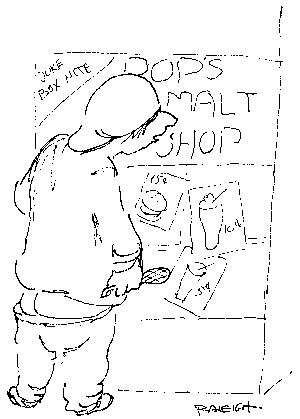How
Hollywood Invented Teenagers
 |
By
HENRY P. RALEIGH
ART
TIMES November 2006
YOU MIGHT NOT know this but before, say, 1950, there weren’t any teenagers. There wasn’t even the word ‘teenagers’ — not in the sense that it could be spoken with a shake of the head and as if surrounded by quotation marks to designate a special category of society bearing its own unique and disturbing characteristics. You see, prior to 1950 there may have been persons who fell within that age group we now are all too familiar with, but no one really noticed them nor were they supposed to be noticed. They were, after all, not quite fleshed out versions of adults, even to dressing more or less just like adults save for the East Coast fashion for knickers which pretty much died out by the late 1930’s. Booth Tarkington’s Penrod and Penrod and Sam describe quite well the general regard for teenagers as amusing yet totally insignificant human beings. It should be noted that the current expression of displeasure with a teenager’s behavior, the rather impotent ‘you’re grounded’, does not appear in parental language until after 1950 and replaced with the far more effective ‘just wait until your father gets home’. This tells you a lot, I think.
Now typical of the classic view of teenagers, or better to say no view whatever, Hollywood films from the silents through the Golden Age paid no attention to this largely invisible segment of the population. Films were about adults and for adults. An actor might well be a teenager as were the Gish sisters and Mary Pickford, yet they always played women, albeit on the short side. Something of a change occurs in the 1930’s. Depression audiences craved light, inexpensive diversions and Hollywood obliged by knocking out screwball comedies and low-budget kiddie films. Shirley Temple, the Little Rascals, Our Gang Comedies — Los Angeles became overrun with parents lugging their young tykes along hoping to cash in on the popularity of the cute-kid flicks. Fat kids, thin kids, pretty, funny-looking, talented or not — all hoped for a shot at stardom but, and I must underscore this, no teenagers. No one wanted teenagers on screen any more than they wanted to see them off screen. Yet something was bound to happen when some of these little performers, through no fault of their own, became teenagers. Mickey Rooney was seventeen when he appeared with everyone’s Mom and Dad, Fay Holden and Lewis Stone, in the 1937 “A Family Affair” and kicked off a fifteen-film series about the Hardy Family. Rooney’s teen love interests included Donna Reed, Judy Garland, and Kathryn Grayson — Ann Rutherford became a regular until the series ended in the mid-forties. In 1938 MGM gave Rooney a special Oscar for “bringing to the screen the spirit and personification of youth”. Teenagers had finally been recognized and boy, were they swell. Given now and then to harmless and adorable pranks, this bunch were just plain American nice. And, goodness gracious, what teen wouldn’t want to live in Carvel, Andy’s hometown?
There was dark side, however, something lurking behind the Norman Rockwell notion of teenagers favored by Hollywood. A hint of this comes through in the 1937 “Dead End”, followed by “Angels With Dirty Faces”. Still, the Dead End Kids were but misguided products of the socio-economic evils of urbanism and had nothing to do with Carvel and real teens singing and dancing at the local malt shop. And to prove nothing had changed there was a nineteen-year-old Shirley Temple being adorable in the 1947 “Bachelor and the Bobby Soxer”.
A harder and less forgiving portrayal of teens in 1949 came with “Knock on Any Door” made from one of a number of social-conscious novels appearing after the war’s end and inspired by the rise of teenage gangs during the war years. Hollywood was beginning to discover a new sort of teenager, one who did not sing or dance but did interesting things with switchblades, zip guns, and chains. Where the 1955 “The Blackboard Jungle” and “Crime in the Streets” in 1956 placed the blame on the gritty urban problem, the 1955 “Rebel Without a Cause” was set in suburbia and saw the trouble lay with lousy parents. James Dean became the inheritor of Mickey Rooney’s old gift to us — a brand new and updated “spirit and personification of youth” — angst-ridden, silky, confused, and rather dangerous. The former Hollywood teen would lamely soldier on for a few years in the hands of a sixteen-year-old Sandra Dee, a Bobby Darin, an Annette Funicello — after Gidget in 1959 the studios by and large ceded the family safe image of teens to banal television sit-coms. The teenagers of “West Side Story” 1961, “Lords of Flatbush” 1974, “Grease” 1978, “The Wanderers” 1979, and a slew of others provided American youth with much more fascinating role models. With Hollywood’s help, teenagers had become a social culture all to themselves, objects of study with entire industries including film, music, clothing, and psychologists devoted to their needs and desires.
Boggles the mind, doesn’t it, to think that only some fifty years ago there weren’t any teenagers — and now look what we’ve got.
